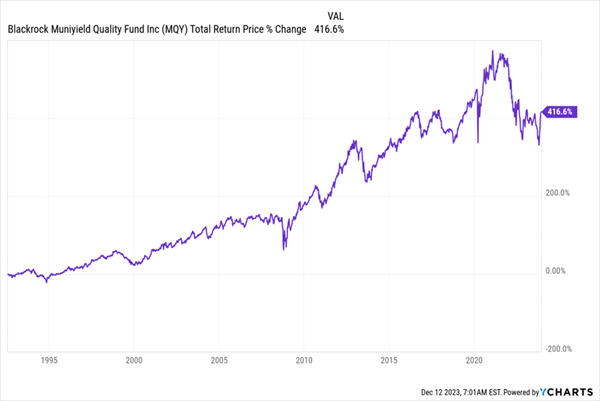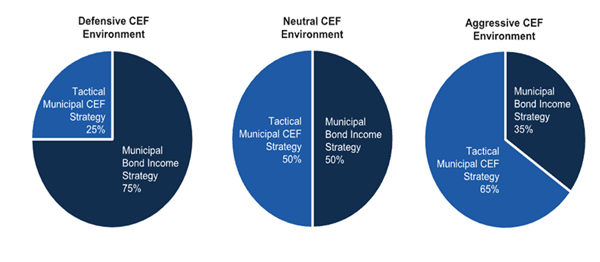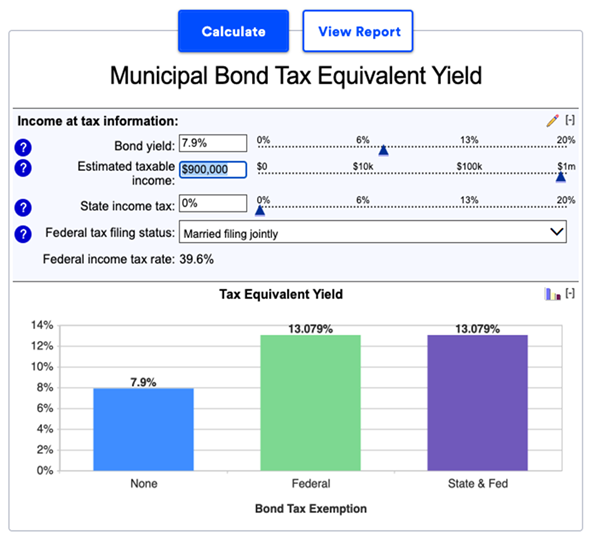Today we’re going to use a simple strategy to (legally!) beat the tax man. The key is a (too) often-ignored group of funds whose dividends are beyond the reach of the IRS.
The low-risk assets behind this income stream really should be part of any income investor’s portfolio. And the three tickers we’ll discuss below, which yield up to 7.9%, are a great place to start. Thanks to their tax-free status, their “real” yields will likely be considerably more for us.
Enter “Boring But Beautiful” Municipal Bond Funds
Here’s the truth on taxes: If you’re an American and you receive any kind of income, you’re going to get taxed. This is a constant of life. But there is one exception: municipal bonds, the income from which is tax-free for most Americans.
That tax-exempt status drives plenty of investors to muni bonds, making them a secret weapon for state and local governments and American industry, as these bonds fund many infrastructure and other public works projects around the country.
It adds up to a big difference-maker for many folks. A municipal, or “muni,” bond yielding 4% might not seem impressive at first glance, but for someone in a 37% federal tax bracket, this 4% tax-free yield is equivalent to a taxable yield of 6.6%.
And of course, the higher our “headline” muni-bond yields get, the bigger the taxable-equivalent yield: for that same taxpayer in the 37% federal bracket, for example, 5% yields turn into 8.3% on a taxable-equivalent basis.
Creating Your Own “Tax-Free Income Machine”
The best way to buy municipal bonds is through closed-end funds (CEFs), which give us three key advantages:
- Active management: The world of municipal bonds is hard for individuals to access, so we want pros from well-established firms like BlackRock, Nuveen and others “running” our muni portfolio for us.
- High yields: Plenty of muni-bond CEFs pay 4%, 5% and more, which, as we just saw, translates into a bigger yield on a taxable-equivalent basis.
- Discounts to net asset value (NAV): Because CEFs have more or less fixed share counts for their entire lives, they can, and often do, trade at different levels than the per-share value of their portfolios, and regularly at discounts. That lets us buy our “munis” for 90, 85 and sometimes even fewer cents per dollar of assets, as we’ll see in a moment.
With all that in mind, let’s go ahead and create a tax-free income portfolio with just three CEFs, all of which are diversified across municipalities, projects and credit ratings.
Muni Pick #1: BlackRock MuniYield Quality Fund (MQY)
MQY is notable for its consistent performance and ability to offer tax-free income for a long time, making it a great long-term hold.
MQY’s Long History of Profits
 MQY currently trades at a 10.9% discount to NAV, so we’re essentially paying 89 cents for every dollar of assets with this one. Cheap! Moreover, like all muni-bond funds, MQY dropped in 2022, as interest rates rose. But now, with rates likely to fall, the fund is nicely positioned for gains, in addition to long-term (and of course tax-free) income.
MQY currently trades at a 10.9% discount to NAV, so we’re essentially paying 89 cents for every dollar of assets with this one. Cheap! Moreover, like all muni-bond funds, MQY dropped in 2022, as interest rates rose. But now, with rates likely to fall, the fund is nicely positioned for gains, in addition to long-term (and of course tax-free) income.
The kicker here is that MQY’s 6% yield—already attractive on its own—“converts” to a 9.9% taxable-equivalent yield for top income earners.
Muni Pick #2: Nuveen AMT-Free Quality Municipal Income Fund (NEA)
Let’s carry on with NEA, known for its strong management team (Nuveen gets access to high-quality municipal-bond issuances early, which is possible thanks to the company’s deep contacts in the muni world and the fact that this corner of the market is small).
Like MQY, NEA trades at a big discount—14.4% this time, That has a little-realized benefit when it comes to the dividend, as the yield on NAV (or the yield management needs to cover to keep the payouts coming our way) is only 4%, lower than the 4.7% yield as calculated on the discounted market price.
That’s a roundabout way of saying the dividend is easy to maintain. And, like MQY, this fund has a long track record of strong total returns and, also like MQY, is well-positioned to gain as interest rates fall.
NEA Keeps Delivering Income and Gains
 Muni Pick #3: RiverNorth Managed Duration Municipal Income Fund II (RMMZ)
Muni Pick #3: RiverNorth Managed Duration Municipal Income Fund II (RMMZ)
Finally, for further diversification in the muni-bond fund space, consider RMMZ, which has an interesting method of managing duration and credit risk: it buys more individual municipal bonds when the muni-bond market is hot and then leans more into buying other muni-bond CEFs when the market is cold and CEF discounts are unusually big.
RMMZ’s Clever Approach to Maintaining Income
 Source: RiverNorth Capital Management
Source: RiverNorth Capital Management
This fund also trades at a wide discount to NAV—13% today—which is yet again a nice bonus for a high-yielding fund. But the real standout stat is RMMZ’s yield: 7.9%. On a taxable-equivalent yield basis, that’s nearly 13.1%. Here are the figures to back up that big yield, courtesy of the taxable-equivalent calculator at Bankrate.com:
Big Yields—for Real
 Source: Bankrate.com
Source: Bankrate.com
RMMZ is far from perfect: its payouts were cut at the start of 2023 by seven-tenths of a penny, and if that were to happen again its current yield would fall to 7.4%. But that still translates into a 12.3% taxable-equivalent yield for a top income earner!
I don’t know about you, but that’s a pretty nice sounding “downside” to me. The upside is that these funds all have diversified portfolios in municipal bonds, which sport just a 0.1% default rate across the asset class.
The bottom line: If you need a tax break (and who doesn’t?), these are three funds worth serious attention.
— Michael Foster
5 More “Hidden” Funds Trading Cheap (and Yielding 9.8%) [sponsor]
I call CEFs “hidden” funds because the big investment houses (which often manage CEFs and ETFs) put almost zero marketing muscle behind them.
There’s a reason for that: if investors discovered the income (and profit) power of CEFs, they’d likely never buy an ETF again! But if we want to retire well—and on dividends alone—9%+ paying CEFs really should be part of our strategy.
To learn more about these high-yield funds, click right here to read my Special Investor Bulletin. In it, I’ll reveal my CEF-investing strategy and give you the opportunity to download a free Special Report naming 5 of my top bargain-priced CEF picks (current yield: 9.8%!).
Source: Contrarian Outlook

